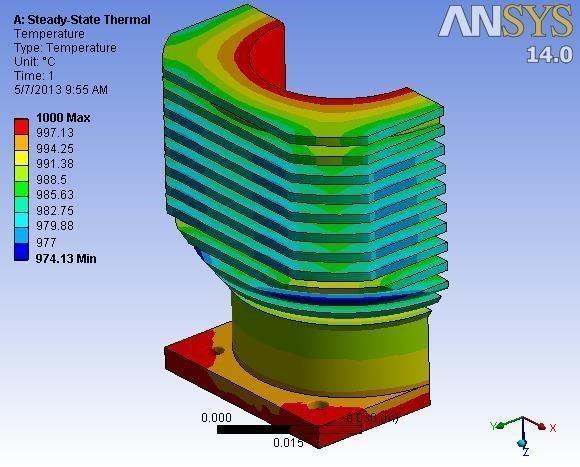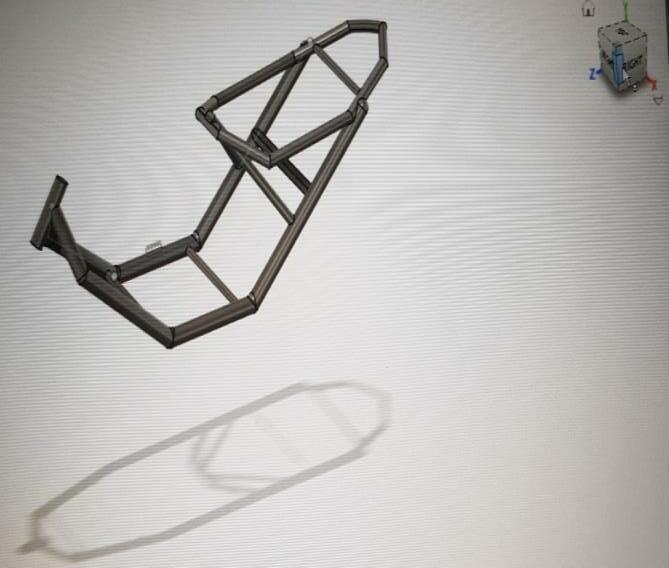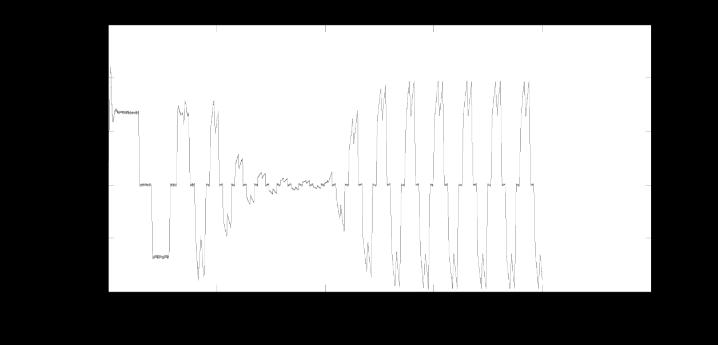International Research Journal of Engineering and Technology (IRJET) e-ISSN: 2395-0056

Volume: 09 Issue: 12 | Dec 2022 www.irjet.net p-ISSN: 2395-0072

International Research Journal of Engineering and Technology (IRJET) e-ISSN: 2395-0056

Volume: 09 Issue: 12 | Dec 2022 www.irjet.net p-ISSN: 2395-0072
2
1
Abstract - A hybrid electric vehicle (HEV), also known asagasoline-electrichybrid,isatypeofvehiclethatuses both a battery and an internal combustion engine to operate. The internal combustion engine in an HEV drivesageneratorthatprovideselectricity,andmayalso power one or more of the wheels. HEVs rely on a combination of both the battery and the internal combustion engine to function, and may offer advantages in fuel economy and environmental impact compared to traditional gasoline-powered vehicles. It has great advantages over the previously used gasoline engine that drives the power from gasoline only. It also isamajorsourceofairpollution.Thegoalofthisproject is to design and build a two-wheeled hybrid electric vehicle that is powered by both a battery and gasoline. The use of both power sources makes the vehicle more versatile and adaptable to different driving conditions. The combination of electric and gasoline power also enhances the overall performance of the vehicle. It providesitsownerwithadvantagesinfueleconomyand environmental impact over conventional automobiles. Hybrid electric vehicles (HEVs) combine an electric motor, battery, and power system with an internal combustionenginetoimprovefueleconomyandreduce emissions. In an HEV, the battery provides power for low-speed driving conditions, where internal combustionenginesaretypicallylessefficient.Whenthe vehicle needs additional power, such as when accelerating, drivingonlonghighways,orclimbinghills, the electric motor provides assistance to the internal combustionengine.Thishelpstooptimizefuelefficiency and reduce emissions. The use of an electric motor to assist the internal combustion engine in an HEV allows for the use of a smaller, more efficient engine. In addition, HEVs utilize the concept of regenerative braking to optimize the use of energy. During braking, energy is normally dissipated as heat. In an HEV, this energy is captured and used to charge the battery. As a result, the vehicle is well-suited for use in urban areas with high traffic, where fuel efficiency and reduced emissions are important considerations. The process of designing and building an HEV typically involves creating a computer-aided design, simulating inverters and other components, conducting a cost analysis of equipment, assembling the internal combustion engine and its components, implementing an electric power drive and designing controllers, and improving the efficiencyofthevehicleincost-effectiveways..
Key Words: Hybrid electric vehicles (HEV), Reduction of rangeanxiety, improvement in mileage, HEV - Hybrid Electric Vehicle AC - Alternating Current DC - Direct Current BLDC - Brushless DC IC - Internal Combustion CVT - Continuously Variable Transmission CADComputer-aided Design PWM - Pulse Width Modulation VSI-VoltageSourceInverter
This project involves the development of a hybrid system that combines an electric power drive with an internal combustion(IC) engineto propel a vehicle.The front wheel is powered by a battery and the rear wheel is powered by gasoline through a single cylinder, aircooled IC engine. A brushless DC motor is used as the electric power drive in this hybrid system. The controller is designed to switch between the IC engine and electric motor based on power needs and load conditions.
The proposed vehicle is based on a scooty having displacement of 90 cc and max power of 5.36 bhp. Proposed add-on includes an hub motor of specifications 750watts,rpm400,ratedvoltage
t he hybrid vehicle which are mainly known as 'hybrid electric vehicle' or 'gasoline-electric hybrid ' which not only work on batteries but also on the internal combustion engine which drives a generator to provide theelectricityandalsodrivea wheel.Theadvantagesof the hybrid electric vehicle over the gasoline based vehicle are gasoline only drives the power & not environment friendly which also do the major air pollution. The main purposeis to design andfabricate a two wheeler hybrid electric vehicle powered by both battery and gasoline. The mixture of gasoline and battery the power makes thevehicle dynamicin nature. Which gives the advantage in fuel economy and environmental impact over conventional automobiles. A hybrid electricvehicleisa typeofvehiclethatcombines anelectricmotor,abattery,andapowersystemwithan internal combustion engine. The purpose of this combination is to achieve better fuel economy and reduce toxic emissions The battery alone provides power for low-speed driving conditions where internal
International Research Journal of Engineering and Technology (IRJET) e-ISSN: 2395-0056

Volume: 09 Issue: 12 | Dec 2022 www.irjet.net p-ISSN: 2395-0072
combustion engines are least efficient. During acceleration, on long highways, or when climbing hills, the electric motor in a hybrid electric vehicle provides extra power to help the internal combustion engine.. This allows a smaller, more efficient engine to be used. Besides it also utilizes the concept of regenerative braking for optimized utilization of energy. Energy dissipated during braking in hybrid electric vehicle is used in charging battery. With the areas of high traffic these vehicles are high suited. The process of manufacturingofahybridelectricvehicleis
1) ThedesigningofthevehicleinCAD
2) Simulations of inverter and other models are done.
3) Equipment and their cost analysis are done. Whichdealswiththefabricationofthevehicle.
4) AssemblyofICEngineanditscomponents.
5) Implementing the electric power drive and designingthecontrollers.
6) Increasing the efficiency of the vehicle in economicwaysisthefinalstepoftheprocess.
History:- Around 93% of the present vehicles run on petrol based products, which are assessed to be exhausted by 2050 . Only 25% of the energy set free from oil and rest is squandered into the climate . Not withstandingongoingendeavorstofurtherdevelopecofriendlinessanddecreaseharmfuldischargesinvehicles, outflows have kept on expanding consistently in the beyond twenty years. An electric vehicle can be a significant forward For conservation of fuel for future and expanding the effectiveness of vehicle an electric vehicle An electric vehicle is sans contamination and is effective at low speed conditions chiefly in high rush hour gridlock regions. However, battery charging is tedious.Inaddition,thesevehiclescan'tgivehighpower expected by drives during rapid circumstances or in slants of uneven regions. The Fuel motor demonstrates itseffectivenessathigherratesinhighwaysandwastea ton of energy in metropolitan regions. A half breed vehicle tackles these issues by joining the benefits of both the frameworks and utilizations both the power sources at their effective circumstances. The ultimate goal of this venture focuses on better use of fuel energy and diminishes reliance on non-sustainable assets utilizing most recent innovation. The advancement of Hybridelectricvehiclewhichinvolvesbatteryaswellas fuelpowerforimpetusofvehicle.
Thefollowingobjectivesaretobeachievedattheendof theproject.
Designandvirtualanalysisofthevehicle.
Designing&AssemblingofICEngine.
Designing & Assembling of the Electrical Power Drive.
Designing & Assembling a two wheeler vehicle design with front wheel powered by electric motor and rear wheel drive powered by an InternalCombustionEngine.
A switching circuit used to switch from IC Enginetotheelectricpowerandviceversa
Implementation of control algorithm by microcontroller
Efficiencycalculationofvehicle.
In a hybrid electric vehicle, the internal combustion engineisleast efficientatlowspeeds,andthe batteryis able to provide power on its own for these driving conditions.. While accelerating, passing, or hill climbing highpowerisrequiredthattimebatteryprovidespower to electric motor as an additional power to assist the engine. Whichallowsa smaller, more efficient engine to be usedThe throttle position sensor (TPS) is a sensor usedtomonitorthepositionofthethrottleinaninternal combustionengine.Thiscontainsahallsensor.Whenthe accelerator throttle angle changes magnetic field is created and it creates voltage across position sensor terminal. Thus for various angles, various voltages . Are obtained.Itconsists ofa throttle positionsensor,i.e,hall sensor. It gives voltage as output with respect to the angle displacement in the accelerator. The analog voltage generated is converted to digital through ADC and is given to microcontroller. If the speed corresponding to the angle deviation in accelerator is less than 30km/hr then the relay is switched onThe relay switching connects the circuit of the battery, inverter,andhubmotorin awaythatallowsthevehicle to be propelled by electric power.If the speed directed by accelerator is greater than 30km/hr, then the engine isstartedbyclosingthecircuitofstartingmotorthrough a relay. The starting motor circuit is activated for five hundred milliseconds such that the vehicle is started. Once the vehicle starts the valve of engine for gasoline intake opens by servo motor. The amount of opening is controlledbythePWMgeneratedbythemicrocontroller asdirectedbytheaccelerator.
International Research Journal of Engineering and Technology (IRJET) e-ISSN: 2395-0056

Volume: 09 Issue: 12 | Dec 2022 www.irjet.net p-ISSN: 2395-0072
=39.24≅40N
Fd= Airdensity⨯cd⨯frontarea⨯V2
Fd= 2
Fd=133.9≅135N
Fa=m.a= = Fa=148.133≅150N Fg=m Fg=170N
Totalforce=rollingforces(fr)+dragforces (fd)+acceleration(fa)+gradient(fg)
Assuming bike doesn’t need high acceleration and not being used in uphill’s, wecanneglectfaandfg ∴ft=40+135=175N

Length=1735mm Width=590mm Height=1060mm grossWeight=200kg
Tyresize=90/90-10 Tyreheight=90x.9=81mm
Tyrediameter=254+81+81=416mm
Tyreradius=208mm Maxspeed=60kmph
• Tyre circumference = 2πx208=1306≅1310=1.35m
• Bike frontage area = width⨯(total height) =590⨯(1060+600)
Bikefrontagearea=0.9794m2
• V=60kmph=16.67m/s
• RPM= = =740rpm
• Coefficient of rolling resistance = 0.02 (cr)
• Airdensity=1.2kg/m3
• Airdrag=0.82 (cd)
Totalforce=rollingforces(fr)+dragforces (fd)+acceleration(fa)+gradient(fg) Fr=m.g.cr=200⨯9.11⨯0.02
Power=Ft⨯V=175⨯16.67=2917.25watt ≅3KW P= ∴3000= ∴T=38.71N.m
Batterycalculations Cc=cellcapacity=2.5amp.hr Vc=cellvoltage=3.7V
Maxspeedtobeachieved(m/s) V=60kmph V= =16.6m/s Vehicletotalmass(kg) M=200kg Rollingforce(Fr)=m.g.cr=200⨯9.11⨯0.02 ∴ =39.24N
Air drag = Fd = Air density⨯ cd⨯ front area⨯V2
Fd= 2 Fd=133.9≅135N
NetforceFnet=Fd+Ff ∴ =135+39.24=174.24N
Power=Fnet ∴ =175 16.67=2917.25watt
International Research Journal of Engineering and Technology (IRJET) e-ISSN: 2395-0056

Volume: 09 Issue: 12 | Dec 2022 www.irjet.net p-ISSN: 2395-0072
Energyused(E)=P T
T= ……D=range,V=velocity
∴T= =1.66
Energyused(E)=P T=2917.25 1.1666
∴Energyused(E)=3.4kwh
Hybrid Electric Vehicle uses battery as one of its power source for vehicle motion during at low power conditions. Batteries are devices that consist of electrochemical cells and provide electrical energy converted from stored chemical energy [5]. Generally batteries are of two types: primary batteries that are disposable and secondary batteries that are rechargeable.
Secondary batteries are preferred for vehicles as they canberechargeable.
There are six major rechargeable batteries available today. They are as follows: lead-acid (Pbacid), nickelcadmium (NiCd), nickel-metal hydride (NiMH), lithiumion (Li-ion), lithiumpolymer (Li-poly), zinc-air [5]. The basic performance characteristics of the battery which influencethedesignareasfollows:
Charge/dischargeratio(c/dratio):
The charge/discharge ratio is defined as the Ah input over the Ah output with no net change in the state of charge. Less the c/dratiobetteristhebattery.
Roundtripenergyefficiency:
The energy efficiency over a round trip of full charge and discharge cycle is defined as the ratio of the energy output over the energy input at the electrical terminals of the battery. More the round trip energy efficiencybetteristhebattery.
Chargeefficiency:
The charge efficiency is the ratio of the amount of electric charge stored within the plates of a device during charging, to the amount of electric charge delivered to the device's external terminals during the charging process.. More the charge efficiencybetteristhebattery.
Internal impedance: Batteries have internal resistances. For the internal resistances present, the battery cannot operate in the fullefficientcondition.Thepowerdelivered at load decreases and hence less is the internal resistance of battery better is its performance.
➢ Temperature rise: Temperature rise is an important factor for batteries as beyond acertaintemperaturevaluethebatterymay lose its charge capacity. Thus, more the temperature sustaining value of the battery betterisitsefficiencyandlifetime.
➢ Life in number of c/d cycles: Batteries have a particular life in number of c/d cycles.Morethevaluebetteristhebattery
TABLE3.1:AverageCellVoltageduringDischargein VariousRechargeableBatteries
ElectrochemistryCell Voltage
Lead-acid 2.0
Nickel-cadmium 1.2 Nickel-metalhydride 1.2
Lithium-ion 3.4 Lithium-polymer 3.0 Zinc-air 1.2
TABLE3.2:BatteryCharacteristicsAffectingThermal Design
Battery Operatin g tempera ture range°C
Lead-acid (Pbacid)
Nickelcadmi um(NiCd)
Overch arge Toleran ce
Heat capacit y Wh/kgK
Mass densit y kg/lite r
Entropic heating on discharge W/A-cell
–10 to 50 High 035 21 –006
–20 to 50 Mediu m 035 17 012
Nickel-metal hydride –10 to 50 Low 0.35 2.3 0.07
Lithium-ion 10to45 Very Low 038 135 0
Lithiumpoly mer 50to70 Very low 040 13 0
Factor value: 7.529 | ISO 9001:2008 Certified Journal | Page1411
International Research Journal of Engineering and Technology (IRJET) e-ISSN: 2395-0056

Volume: 09 Issue: 12 | Dec 2022 www.irjet.net p-ISSN: 2395-0072
•Itissmallinsize.Itcanhavehightorqueatlowspeed.
Lead-acid (Pbacid)
Nickelcadmium (NiCd)
Nickel-metal hydride
Specific Energy Wh/kg
Energy Density Wh/liter
Specific Power W/kg
Power Density W/liter
30–40 70–75 ~200 ~400
40–60 70–100 150–200 220–350
50–65 140–200 ~150 450–500
Lithium-ion 90–120 200–250 200–220 400–500
Lithiumpolymer 100–200 150–300 >200 >350
Zinc-air 140–180 200–220 ~150 ~200
Battery Cycle life in full discharge cycles
Calendar life in years
Self discharge rate %/monthat 25°C
Relative cost $/kWh
Lead-acid (Pbacid) 5001000 5-8 3-5 200-500
Nickelcadmium (NiCd) 10002000 10-15 20-30 1500
Nickel-metal hydride 10002000 8-10 20-30 2500
Lithium-ion 5001000 5-10 3000
Lithiumpolymer 5001000 1-2 >3000
Zinc-air 200-300 4-6
The performance characteristics and properties of various electrochemistries presented in the preceding sectionsaresummarizedandcompared.Itisnotedthat despite of little advantages in all the factors, the overall cost of the lead-acid battery is low compared to NiCd, NiMH and Li-ion batteries. Because of its least cost per Wh delivered over the life, the lead-acid battery is best suited for vehicle application where low cost for customersarenecessary.
BLDC motor is a closed loop synchronous motor. It has all the characteristics of DC Motor with some added features.Itadvantagesareasfollows:

•Itischeap.
• It can save 30% to 50% of power consumed by a normalmotorandhashighefficiencyof80%to90%.
•Speedrangecanbecustomized
• Replace the AC + frequency equipment minimizing harmonicsintroductiontothecircuit.
During the combustion of gasoline in an internal combustion engine, high temperature gases are generated, which can increase the temperature of the cylinderhead.Todissipatethisheat,thecylinderheadis often equipped with long, conductive radiating fins. However, high temperatures can also affect the performance ofthe engineandcan cause combustion of the lubricating oil. Figure 1.1 shows the temperature distribution of the cylinder head when the vehicle is running at higher speeds, with heat transfer occurring mainly through convection. The figure is color-coded, with red indicating higher temperatures and blue indicating lower temperatures. Figure 1.2 shows the heatfluxdistributioninacylinderhead,whileFigure1.3 showsthestressanalysisofthechassis.Thebluishareas experience less stress, while the reddish areas experience more stress, and the chassis must be designed with care in these areas. Figure 1.4 shows the inverter output of an electric vehicle, with the square wave produced being fed to the motor for maximum efficiency. Figure 1.5 shows the variation of torque, speed,outputvoltage,andarmaturecurrentovertimein theelectricdrive.








International Research Journal of Engineering and Technology (IRJET) e-ISSN: 2395-0056

Volume: 09 Issue: 12 | Dec 2022 www.irjet.net p-ISSN: 2395-0072
Accessories
Tyre
Front 3.0x10
Rear 3.0x10
Brakes Front 130mmDrum
Rear 130mmDrum Suspension
Equipment'sused:
ICEngine
SIEngine
Justification
Front Bottom link with spring loaded hydraulic damper, 80mm travel
Rear UnitSwingwith spring loaded hydraulic damper, 75mm travel
Number of Cylinders Single Cylinder Displacement incc 100c
Stroke 4-stroke 4 stroke engines have better efficiencyandthis engine commercially cheaper than otherengines.
Cooling AirCooled
FuelSupply Carburetor Available Models Pep
PowerTrain Its automation is much simpler than geared transmission.
Transmission Variomatic (CVT)

Availability Comes with engine
ElectricMotor
BLDCHubMotor
Justification
Clutch Dryautomatic Centrifugal
Microcontroller Atmega 1250
ServoMotor PWM Controlled 15kg/cm
RPMSensor Hall Effect Sensor 5v operating voltage StirlingEngine Electronics Varo Board, Wires, transistors,etc Fabrication: Component
Power 750.0watts
Operating Voltage 48Volts High efficiency and better load carrying capability.
MaxRPM 380.0rpm MaxCurrent 15amps
Battery High discharge capability Voltage 48volts Capacity 15Ah
International Research Journal of Engineering and Technology (IRJET) e-ISSN: 2395-0056

Stirling Engine 100% -
Suspension 100%Tyre 100% -
Motor Controller 0% 100%
Power Control System
0% 100%
Assembly of components 0% 100%
A hybrid electric vehicle (HEV) is a type of vehicle that uses both a gasoline engine and a battery as sources of power. In an HEV, the battery is used for low power applications, while the gasoline engine is used for high power applications where a higher level of power is required. The gasoline engine is most efficient at high speeds,whilethebatteryismoreefficientatlowspeeds. As a result, an HEV is able to operate at maximum efficiency in both modes of operation. However, the gasoline engineisnotefficientatlowspeeds,soanHEV isabletoachievesignificantlybetterfuel efficiencythan a traditional gasoline-powered vehicle. In addition, an HEV produces 50% fewer emissions than a traditional vehicle, making it an effective means of reducing pollution in urban areas, particularly in high traffic situations where the efficiency of a gasoline engine is typicallylowandemissionsareaconcern.
Thecurrentsocietymostlydependsonpetroleumasthe major source power for vehicle propulsion. The electric vehicleisnotveryefficientforallpowerconditions,i.e,it cannot provide power for high speed conditions. Through the project a hybrid method of both the vehiclesisproposedwhichutilisestheefficiencyofboth the vehicles. This method is implemented in twowheeled vehicles that are mostly preferred by public. Thus proper manufacturing and cost analysis can make thevehicleamajorbreakthrough.
[1]AlternativeFuelsandTechnologies
[2] Oil depletion analysis centre. ODAC Newsletter - 6 July2012.http://www.odacinfo.org/newsletter/2012/07 /06
[3]M.J.Riezenman,“Electricvehicles1992.
[4] H. Shimizu, J. Harada, C. Bland, K. Kawakami, and C. Lam, “Advanced concepts in electric vehicle design,” IEEETrans.Ind.Electron.,vol.44,pp.14–18,Oct.1997.
[5] C. D. S. Tuck, Ed., Modern Battery Technology. Harwood,p.411,1991.
[6] M. Terashima, T. Ashikaga, T. Mizuno, and K. Natori, “Novel motors and controllers for highperformance electric vehicle with four in-wheel motors,” IEEE Trans. Ind.Electron.,vol.44,pp.28–38,Feb.1997.
[7] R. Prabhakar, S. J. Citron, and R. E. Goodson.“Optimization of Automobile Engine Fuel EconomyandEmissions.”1975.
[8]V.Wouk,“Hybrids:Thenandnow,” 1995.
[9] C. Kricke and S. Hagel, “A hybrid electric vehicle simulation model for component design and energy managementoptimization,”1998.
Volume: 09 Issue: 12 | Dec 2022 www.irjet.net p-ISSN: 2395-0072 © 2022, IRJET | Impact Factor value: 7.529 | ISO 9001:2008 Certified Journal | Page1415